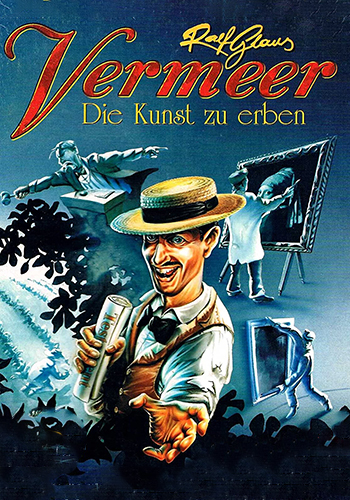Vermeer: The Art to Inherit

-
Information
-
Original Soundtrack
(H)art heritage
If you now look at the game Vermeer: The Art to Inherit with this mindset, a similar picture emerges. Apart from the really fantastic play on words (after all, the aim is to acquire as many works of art by the baroque Dutch artist as possible), the game offers gaming enthusiasts comparatively little - both in terms of gameplay and story. This can be summarized quite briefly: Our Uncle Walter von Grünschild is not only facing the soon ending winter of his life, but has also suffered a bitter loss: His most valuable paintings have been stolen! Our task now is to buy as many of them back as possible and not let anyone sell us any forgeries, because only then will we be appointed heirs to his immense wealth. So far, so simple.
In order to obtain the necessary capital, we acquire plantations around the world, trade in shares and risk papers, bet on horse racing or sabotage our three family members who are vying with us for the family estate. Vermeer is therefore an economic simulation at heart, albeit a simple one due to the limited options. For example, only four crops can be cultivated (coffee, tea, tobacco and cocoa) and there are no in-depth value-added cycles. The actual gameplay also exhausts itself quite quickly: collect money, expand, buy works of art, repeat. There are no alternative objectives.
However, that was enough for me to spend many happy hours with the game back then. To use the comparison from the beginning, Vermeer was my pasta with ketchup. After all, due to a lack of knowledge, let alone ownership of other economic simulations, I had nothing comparable. And the graphics in the form of drawn pictures had always reminded me a little of the Löwenzahn (Dandelion)-games, which I was very enthusiastic about at the time. That doesn't mean I was any good. Being good and having fun can be two very different things, as my friends proved to me anew in every gaming session.
Unfortunately, I had to look up most of the information about the game on the Internet, and nothing really stuck with me back then. I suppose getting to grips with the capital market as a 7-year-old would have been a bit ambitious and I still can't do it today. But whereas Transport Tycoon at least taught me what subsidies meant - which I was subsequently able to impress my sociology teacher Mrs. Holwe with - I didn't even know that Vermeer was a real person. If I had been shown The Girl with the Pearl Earring at the time, I would probably have stubbornly claimed that it was from this game. Another opportunity for lesson on art history passed by unused.
Fortunately, since music also belongs to the arts, I can at least contribute something to the game's soundtrack today. It was composed by Jürgen Venjakob, who, according to Mobygames, diligently changed departments in subsequent game projects and at one time worked as a graphic artist, marketer and web designer. This comes to me as no surprise, as the score comprises 14 tracks with an average duration of 1.5 minutes, none of which are particularly remarkable. It helps that the tracks with their lack of highlights can be listened to quite quickly and are at least thematically varied. All of them are dedicated to the respective cities that we can visit in Vermeer.
As a result, Ankara has an Arabic touch, New York sounds like big city swing with its jazzy horns and in Lissabon the MIDI guitar calls for a tango. This seems fitting, but is torpedoed by other stylistic decisions. Why do pieces like Paris suddenly feature change of metres, making you feel as if you are constantly being thrown off course acoustically? Why does Berlin with its barrel organ sound almost like a circus? And how kitschy Asian can we make Bombay? Venjakob answers: "Yes."
No, the music to Vermeer: The Art to Inherit is not really exciting ... but did that surprise anyone? You would find most of the pieces on various music databases today, and the squeaky MIDI charm is probably only something for retro nostalgics. For me, the feel of the score brought back pleasant memories of other contemporary games such as Dr. Drago's Madcap Chase , which perhaps explains the rather forgivable ratings of the individual tracks. However, this assessment, which is at least reminiscent of average, should not be misleading: for non-Mattisse, the OST is really not very exciting.
Nostalgia warning
-
Original Soundtrack


